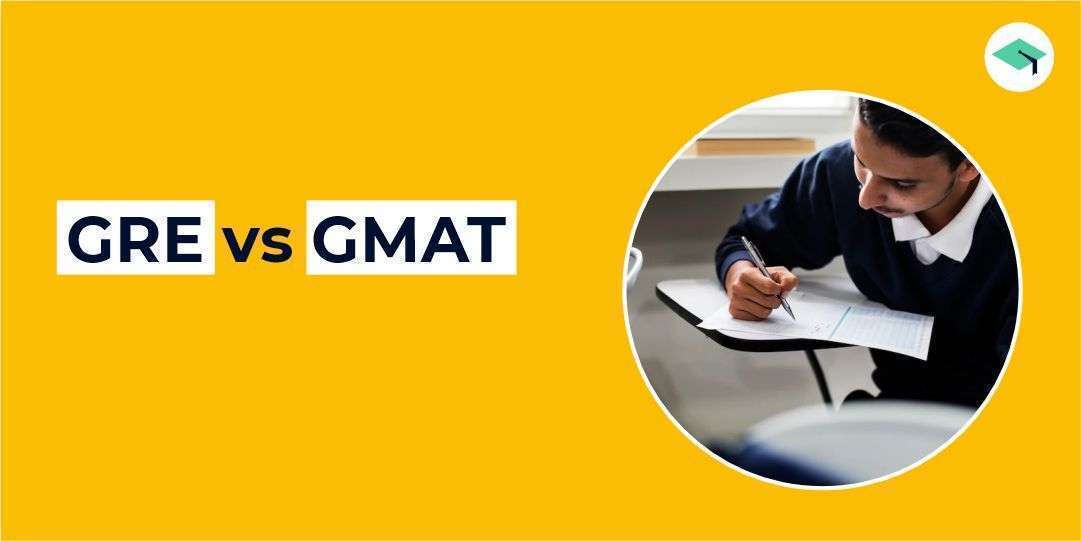GRE vs GMAT: Which is better?

GRE and GMAT are considered two of the many pathways to study at top colleges and universities across the globe.
Students clearing the Graduate Record Examination (GRE) with a good score (we will discuss this later in this article) become eligible for admission to graduate study programs.
On the other hand, the Graduate Management Admission Test (GMAT) is an undisputed road toward admission to top MBA programs all over the globe.
Students often find themselves at a crossroads when choosing which exam to prepare for.
GRE vs GMAT: What are the Exam sections?
- Verbal
- Quantitative aptitude (including integrated reasoning in GMAT)
- Analytical writing
Let us compare between GRE and GMAT in a summarized table below
| Basis of Distinction | GRE | GMAT |
| Body of governance | Education testing services | Graduate management admission council |
| Exam duration | 3.75 hours | 3.5 hours |
| Test structure | 60 minutes: Analytical writing section. 2 essays with 30 mins each. 2 sections of 30 minutes (20 questions) each for verbal reasoning. 2 sections of 35 minutes (20 questions) each for quantitative reasoning. 1 experimental section (30 – 35 minutes) each verbal or quant. | 30 minutes: Analytical writing section. 30 minutes: 1 section for integrated reasoning (12 sections). Quantitative section: 62 minutes (31 questions). Verbal section: 65 minutes ( 36 questions) |
| Cost of exam | $205 | $250 |
| Validity of scores | 5 years | 5 years |
Composition of the sections
1. Analytical writing section
The GRE Analytical section has two essays, one needs an analysis of an issue, and the other one requires an analysis of an argument.
The GMAT Analytical section has one essay requiring critical analysis of an argument.
2. Verbal section
The GRE verbal section has questions of three types, namely, reading comprehension, test completion, and sentence equivalence.
Reading comprehension requires questions to be answered based on given passages, text completion is synonymous with fill-in-the-blanks, and the sentence equivalence parts have questions having sentences with one blank.
The examinee has to choose two options (from six) that fit the sentence similarly.
GMAT verbal section consists of questions on reading comprehension, critical reading of passages, and sentence correction questions. The questions test the student’s understanding, reasoning, critical analysis, and grammar skills.
3. Quantitative section
The GRE quantitative reasoning section comprises questions from topics like algebra, geometry, numbers, and data interpretation. Question types include numeric value entry questions, MCQs, and comparison questions.
This section of the GMAT exam has questions on problem-solving and data sufficiency. In addition, integrated reasoning includes questions on data interpretation involving graphs, charts, and tables.

Which exam is easier?
A significant query in the test-taker’s mind is the difficulty of the two exams. No exact answer to this because both these are aptitude exams – to test various capabilities of a student on a subjective basis.
On average, the GMAT has a more challenging Quantitative section, whereas the verbal section in the GRE is a challenging game because of the need for a vast vocabulary and two types of essay
Who should take the exam?
GRE is for students of almost all backgrounds looking to study a masters-level program or a Ph.D. program from some of the best universities in the world – it is a trendy exam among STEM students and economics students.
GMAT is the go-to exam for students with the big B-School dream as almost all top business schools have this exam mandatory under normal circumstances.
Difference between GMAT and GRE:
- GMAT:
- MCQs math questions
- Accepted by most graduate business programs
- Test is online at a test center
- $250 fees (approx. Rs 21,000 in India)
- 3 hours a long test.
- Scores good for 5 years
- 4 sections in the syllabus
- GRE:
- MCQs math questions
- Accepted by most graduate programs
- Online test
- $205 fees (approx. Rs 17,000 in India)
- 3 hours 45 minutes long test
- Score well for 5 years
- 3 sections in the syllabus
Should you take the GMAT or the GRE?
It’s customary for business schools to take GRE results as part of their admissions criteria, despite the fact that the overwhelming majority of applicants to business schools opt to take the GMAT rather than the GRE.
This implies that you can select the test that best demonstrates your academic strengths. Here are a few things to think about as you decide what is best for you.
Academic objectives: The GRE is accepted in a wider range of degree programs, so if you’re thinking about different graduate schools or just want to keep your options open, you should consider taking it.
Taking the GMAT will show your dedication if you’re confident you want to attend business school, taking the GMAT will show your dedication.
School: Many colleges accept either score, but it’s a good idea to double-check the admissions requirements in advance. Ask an admissions counselor if they have a choice between the two exams if at all possible.
Academic talents: The GMAT may provide a better opportunity to showcase your skills if your arithmetic abilities seem to be better than your verbal abilities.
If you’re a good writer, think about taking the GRE. For non-native English speakers, the GRE might occasionally be more difficult due to the vocabulary required.
Testing method: The GRE format enables you to jump around and review your responses if you choose. This could boost the confidence of some test-takers.
Performance on practice exams: Taking a practice test for each examination is one technique to figure out which one you’re best suited for.
Take them individually under conditions that are as real-world as possible. You’ll have a better notion of that which you feel more often at ease with when you take and grade your examinations.
Score reporting: If you sit the GRE more than once, you have the option of sending different scores to different schools. Schools receive all of your GMAT results. Many programmers just take the highest score into account.
Career aspirations: Some employers, especially investment and business consulting businesses, need GMAT scores as a part of the hiring process.
Do your homework on these needs in advance if you have particular target employers in mind. You might avoid having to take the GMAT throughout your job hunt if you take it before applying to business school.
FAQs
Which is easier GMAT or GRE?
According to experts, the GMAT’s quantitative problems are typically more challenging than the GRE’s. Thus, Dan Edmonds, a test-prep tutor with Ivy Wise, noted in an email, “Students with higher math skills may prefer taking the GMAT in order to exhibit those talents.
Which is more valuable GRE or GMAT?
Clearly said, the GMAT is a more trustworthy test for determining an MBA applicant’s likelihood of academic achievement, so the admissions process will value your GMAT scores much more than your GRE scores.
Do colleges prefer the GMAT or GRE?
For MBA applications, almost 90% of business schools accept GRE results. You will only be at a loss if the business school explicitly declares that it favors the GMAT over the GRE if you take the GRE for MBA admission. Nevertheless, the GMAT still retains an edge over the GRE for MBA admissions.
Is GMAT or GRE better for an MBA?
The GRE is an exam that students may take to obtain admission to graduate programmers across practically all subjects, such as the MBA, while the GMAT is a test that is exclusively created for applicants to business schools. The GMAT has typically been given preference over the GRE.
recommended reading
10 Benefits of Studying in Canada!
10 Reasons Why You Should Study in the USA
11 reasons to study in Australia
4 essential tips on investing in your child's education
4 Reasons why you should have an EduFund
5 Reasons why Global Education is the Best for Indian Students
5 reasons why your child's college education is at stake
5 steps to apply for art school admission
5 ways to deal with rising college fees for your child!














